26.07.2020
Mars rover revival

As Mars exploration prepares for a rebirth, a European rover tunes up its gear for the challenges ahead.
Tomorrow, 23 July, ESA and dozens of industrial partners will assess the readiness of the ExoMars robotic explorer, named Rosalind Franklin, for a trip to the Red Planet in 2022. The European rover will drill down to two metres into the martian surface to sample the soil, analyse its composition and search for evidence of life buried underground.
The rover successfully proved that it is fit to endure the martian conditions during the environmental test campaign earlier this year in Toulouse, France. This laboratory on wheels withstood temperatures as low as –120°C and less than one hundredth of Earth’s atmospheric pressure to simulate the extremes of its journey through space and on the surface of Mars.
By the end of this week a more robust set of solar panels will begin its trip to reunite with the rover after some cracks were detected during those environmental tests. New fasteners are in place and will be on their way from the Airbus facilities in Stevenage, in the UK, to Thales Alenia Space in Turin, Italy, where the rover awaits power up at the beginning of August.
The disruptions caused by the coronavirus pandemic have added new obstacles for industry across Europe on the road to Mars. Parachute and interface tests are expected to resume in October.
New missions to Mars launch from a broad range of nations – while the United Arab Emirates’ historic first mission to Mars lifted off from Japan last Sunday, China is preparing to launch tomorrow its first rover to Mars, known as Tianwen-1. NASA’s Mars 2020 mission is set to take off with the Perseverance rover onboard next week, on July 30.
These missions focus on the search for evidence of life on the Red Planet and a better understanding of how Earth and Mars evolved so differently.
“We hope that ESA’s Rosalind Franklin rover will help write a new page in Mars exploration by allowing us to study organic molecules on the spot,” says Jorge Vago, ESA’s ExoMars project scientist.
Dr Rosalind Franklin, the prominent scientist behind the discovery of the structure of DNA, one of life’s most important molecules, would have been 100 years old on 25 July this year. Her niece, also named Rosalind Franklin in her memory, points out that the X-ray diffraction expert “never conceived science as a race of competitors.”
After a visit to ESA’s technical centre in the Netherlands last year, Rosalind believes that her aunt would have loved the ExoMars team spirit. “The work of ESA engineers on the rover struck me – they really do it for the results, not for themselves. This is what Rosalind Franklin was all about: commitment and dedication to science,” said Rosalind from her home in California, US.
A series of talks and events is taking place around the globe this week to celebrate the centenary of this “woman of integrity who went after scientific discovery for the betterment of humankind”, as her niece describes her. The legacy of the scientist lives on today, and the ExoMars rover will help leave her symbolic footprint on Mars in 2023.
The ExoMars rover is part of the ExoMars programme, a joint endeavour between ESA and the Russian State Space Corporation, Roscosmos.
Quelle: ESA
----
Update: 3.10.2020
.
The way forward to Mars

The path that ExoMars 2022 will follow to reach the Red Planet is set. The trajectory that will take the spacecraft from Earth to Mars in 264 days foresees a touchdown on the martian surface on 10 June 2023, at around 17:30 CEST (15:30 UTC).
The weather at Mars, the type of launcher and the laws of physics governing the planets determined a 12-day launch window starting on 20 September 2022.
Efficient orbital transfers, good communications and no large dust storms on the martian horizon make the chosen trajectory the fastest and safest choice.
Choosing the best path
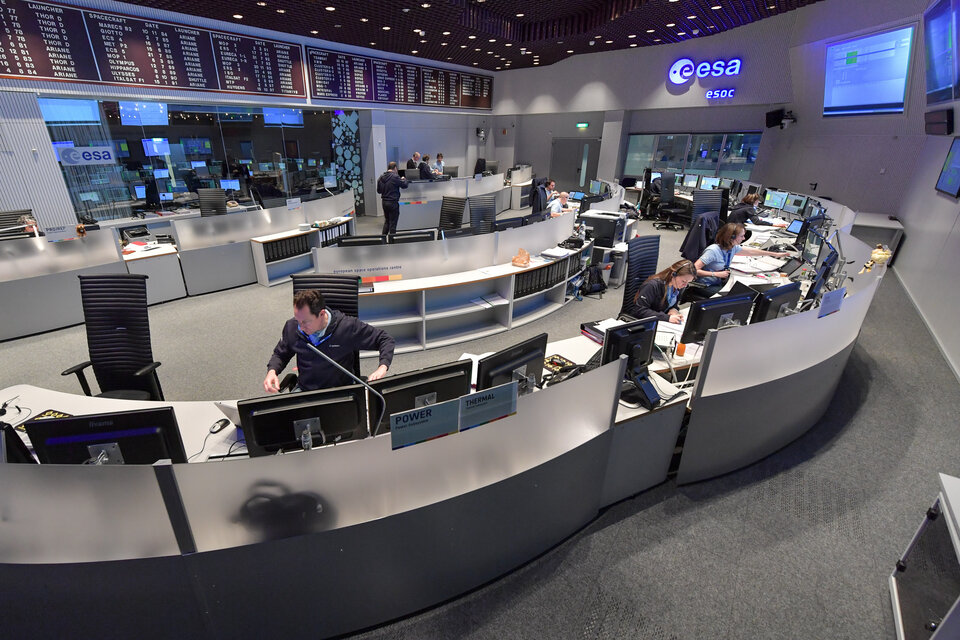
When confronted with how to get to Mars, European and Russian teams have to juggle many factors. The mission analysis team at the European Space Operations Centre (ESOC) in Germany took into account the performance of Russia’s Proton launcher to identify a number of possible trajectories.
“We had several transfer trajectories to choose from and a spacecraft already built for the trip,” says Mattia Mercolino, ExoMars principal systems engineer. “These variables imposed on us constraints linked to power, temperature thresholds and orientation towards Earth during the first stages of the flight, among others.”
Being able to communicate with the spacecraft also played a major role.
“One of the alternatives had a longer launch window, but a worse connection with the spacecraft during the first days. This choice was too risky, especially when you want to have full control at the beginning of the mission,” explains Tiago Loureiro, ExoMars spacecraft operations manager.
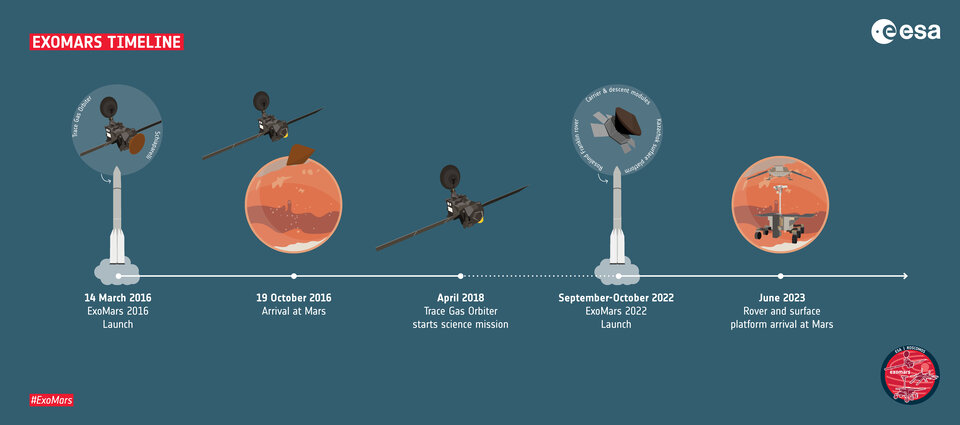
The final trajectory takes a bit longer – one week more – and the launch sequence requires more manoeuvres, but this wasn’t only about earthly constraints. “We needed to understand the challenges unique to our destination. Mars orbital characteristics and dust storms were crucial to our decision,” says Tiago.
Riders on the storm

Dust storms are frequent on Mars, but also difficult to predict. Seasons play a role, with stormy weather more likely to happen during the spring and summer in the southern hemisphere. ExoMars landing site is Oxia Planum, located in the northern hemisphere.
Threatening global-scale dust storms tend to happen approximately every ten years. The most recent one was in 2018.
Although ExoMars will land outside the dust storm season, a build-up of dust on the solar panels will reduce power supply and could even force a temporary shutdown of ESA’s Rosalind Franklin rover and the Russian surface platform, dubbed Kazachok.
“We went through a number of studies and tests to ensure that all systems would survive with reduced sunlight upon the late afternoon landing, and during surface operations the following weeks,” adds Tiago.


Access the video
European scientists want to operate the rover on Mars for as long as possible. Rosalind Franklin can cope with regional dust storms for a few days and with layers of fine dust covering its solar panels.
“A global dust storm that blankets the atmosphere for several months would most likely result in the death of the rover,” warns Jorge Vago, ESA’s ExoMars rover project scientist.
“That is why it is so important to achieve most of the mission objectives before the problematic dust season starts,” he adds.
Earth at work
It took the teams at ESOC a few months of work to narrow down the final launch date and trajectory to Mars. “The whole challenge is fantastic – I think I have the best job in the world,” says Tiago.
“Launching a spacecraft, shooting it across the Solar System, hoping it lands in one piece, deploying it, driving it on Mars… And we will do all of this without the luxury of interacting with the spacecraft or the rover in real time,” he explains.

Sending the first European rover to Mars requires true teamwork. Each and every command has been carefully planned together with the Russian partners, involving several control centres and countries.
ESA will control the communications between Rosalind Franklin and the Kazachok surface platform during their first days on Mars. As part of the ExoMars programme, the Trace Gas Orbiter, which has been circling Mars for nearly four years, will serve as a data relay platform to support communications.
A few weeks after landing, and only when the surface platform is safe and able to operate independently, ESA will hand over the control of Kazachok to Roscosmos.
About ExoMars
The ExoMars programme is a joint endeavour between the Roscosmos State Corporation and ESA. Apart from the 2022 mission, it includes the Trace Gas Orbiter (TGO) launched in 2016. The TGO is already both delivering important scientific results obtained by its own Russian and European science instruments and relaying data from NASA’s Curiosity Mars rover and InSight lander. The module will also relay the data from the ExoMars 2022 mission once it arrives on Mars.
Quelle: ESA
----
Update: 19.11.2020
.
ExoMars parachute testing moves forward
The parachute system that will help deliver the Rosalind Franklin ExoMars rover to Mars has completed the first full-scale high altitude drop test with redesigned elements following two unsuccessful tests last year. Parachute extraction and deceleration proceeded as expected, the test vehicle landed safely and the test parachutes were recovered. However, some canopy damage occurred, pointing to the early inflation process for the focus of further improvements.
“Landing on Mars is extremely difficult, with no room for error,” says ExoMars Programme Team Leader Francois Spoto. “The latest test was a good step forward but is not yet the perfect outcome we are seeking. Therefore, we will use the extensive test data we have acquired to refine our approach, plan further tests and keep on track for our launch in September 2022.”
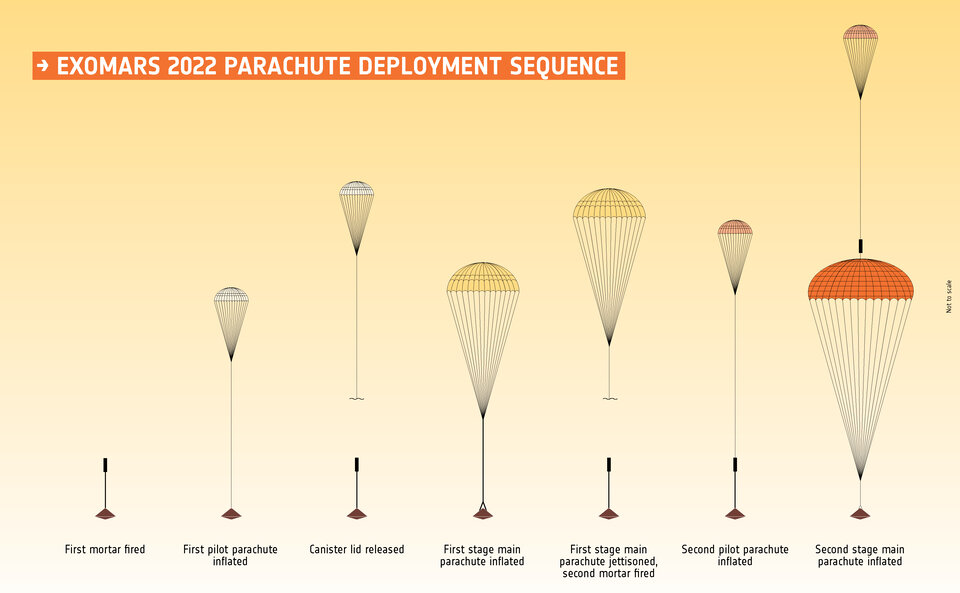
Parachute profile
The Rosalind Franklin rover and Kazachok surface platform are encapsulated inside a descent module that will be transported to Mars by a carrier module. The descent module is equipped with two parachutes – each with its own pilot chute for extraction – to help slow it down prior to landing on Mars. Once the atmospheric drag has slowed the descent module from around 21 000 km/h to 1700 km/h, the first parachute will be deployed. Some 20 seconds later, at about 400 km/h, the second parachute will open. Following separation of the parachutes about 1 km above ground the braking engines will kick in to safely deliver the landing platform onto the surface of Mars. The entire sequence from atmospheric entry to landing takes just six minutes.
The complete parachute descent system needs testing and verifying on Earth, for which high altitude drop tests play an essential role to help represent the low atmospheric pressure on Mars – a vital aspect when considering parachute inflation.
New round of high altitude tests
The test conducted from Oregon, USA was delayed from March 2020 due to COVID-19 restrictions, forest fires and unfavorable wind conditions. Logistics re-planning and compatible weather finally enabled it to take place 9 November.
The test setup saw the drop test vehicle lofted to a height of 29 km in a stratospheric balloon.
The first main parachute had an upgraded parachute bag and a Kevlar reinforcement around the vent hem (that is, around the vent 'hole' in the centre of the parachute). The second main parachute had several reinforcement rings and an upgraded parachute bag, but not reinforced parachute lines, which are also planned. The fully upgraded second parachute will be used in a drop test at the Swedish Space Corporation Esrange facility in Kiruna, Sweden in mid-2021. The reinforcement rings were introduced to help prevent the dramatic tearing of the canopies witnessed during tests in 2019.
The timeline of the latest test, including extraction and deceleration, went exactly to plan. However, four tears in the canopy of the first main parachute and one in the second main parachute were found after recovery. The damage seemed to happen at the onset of the inflation, with the descent otherwise occurring nominally.
The team are now analysing the test data to determine further improvements for the next tests. Planning is underway for future tests in the first half of next year, to ‘qualify’ the complete parachute system ready for launch in September 2022.
Once safely in the Oxia Planum region of Mars in June 2023, the Rosalind Franklin rover will drive off the platform and begin its science mission. It will seek out geologically interesting sites to drill below the surface, to determine if life ever existed on our neighbour planet.

All parachute system qualification activities are managed and conducted by a joint team involving the ESA, TASinI (prime contractor), TASinF (PAS lead), Vorticity (parachute design and test analysis) and Arescosmo (parachute and bags manufacturing).
The ExoMars programme is a joint endeavour between ESA and Roscosmos. In addition to the 2022 mission, it also includes the Trace Gas Orbiter (TGO) launched in 2016. The TGO is already both delivering important scientific results of its own and relaying data from NASA’s Curiosity Mars rover and InSight lander. It will also relay the data from the ExoMars 2022 mission once it arrives at Mars in 2023.
Quelle: ESA
----
Update: 9.12.2020
.
Euro-Russian Mars rover mission takes shape

A key milestone has been reached in the preparations for the joint European and Russian mission to Mars, scheduled for launch from Earth in 2022.
The Rosalind Franklin rover, which will search for life, has been mated to the Kazachok platform that will land it on the surface of the Red Planet.
It's the first time the two have been joined together.
The fit-check was conducted by engineers at the Cannes, France, factory of Thales Alenia Space.
The UK-assembled robot is seen sitting atop the lander in a folded configuration - as it will be for the journey to, and the touchdown on, Mars.
The rover and lander will later be enclosed in a capsule and then attached to a cruise module.
The capsule's job will be to protect the Franklin robot and Kazachok platform from the searing heat that is encountered on entry into Mars' atmosphere. The cruise module is the vehicle that shepherds the whole mission to the Red Planet after launch.
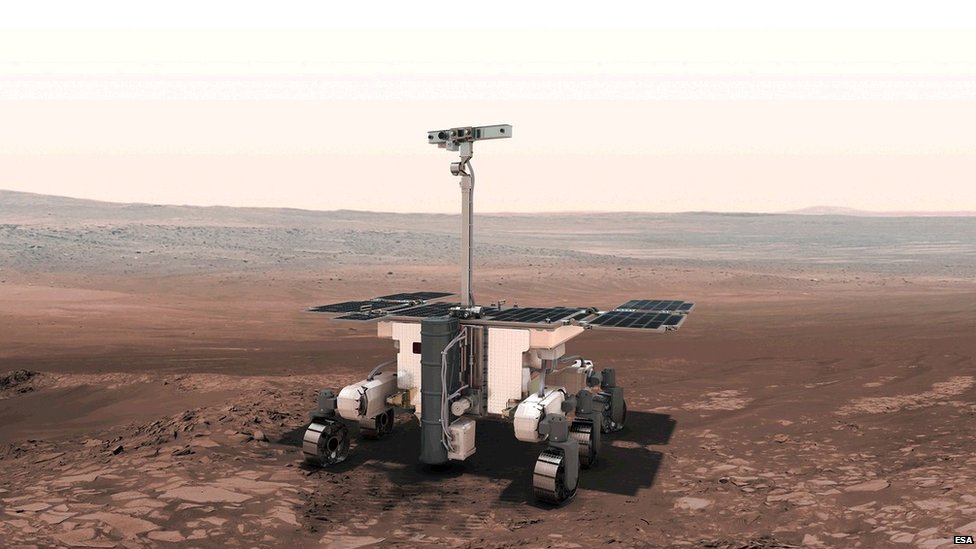 IMAGE COPYRIGHTESA
IMAGE COPYRIGHTESAAll the elements must go through not only a physical fit-check, but an assessment of the electrical, power and data-connections between them.
Once the work at Cannes is compete, the four major parts of the "stack" will be disassembled for despatch to the Baikonur launch site in Kazakhstan. Re-assembly will include the insertion of some radioisotope heaters in Rosalind Franklin to help ward off the freezing temperatures on Mars.
The mission is targeting a September 2022 liftoff, with a landing at the Red Planet in June 2023. The destination is an ancient terrain called Oxia Planum. Scientists hope there might be evidence there of microbial activity, if only billions of years in the past.
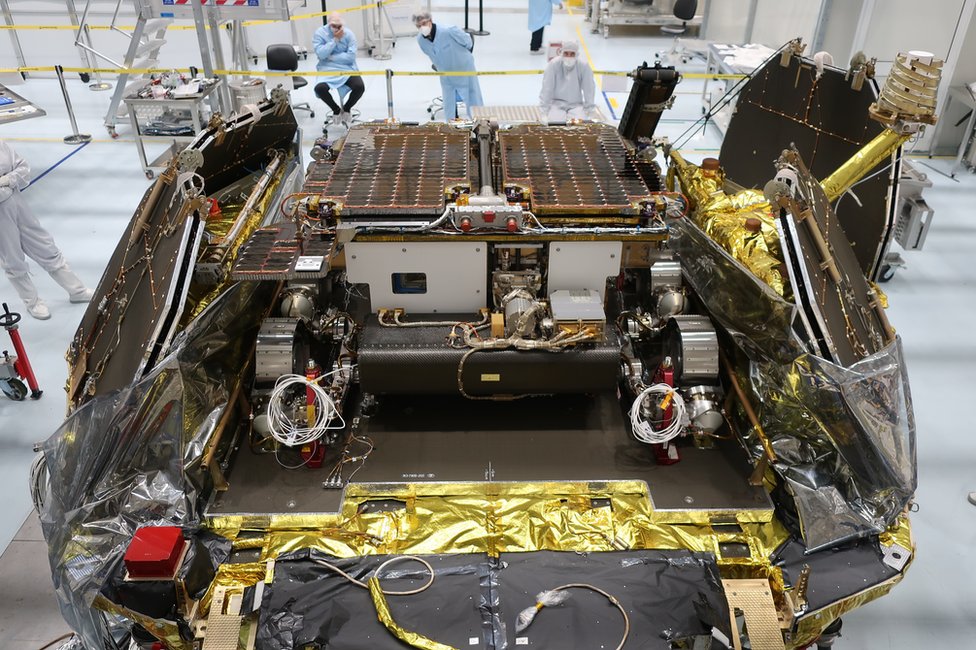 IMAGE COPYRIGHTTAS
IMAGE COPYRIGHTTASKnown as the ExoMars project, the joint European-Russian venture should have left Earth in July/August this year but the hardware could not be prepared in time - in part because of the difficulties introduced by the Covid-19 crisis.
The picture at the top of this page shows the rear of the rover and a ramp for rolling down on to the surface.
In the second image from the Cannes factory, you can see the front of the rover (there is a second ramp out of view). The rover's drill system, which will reach 2m below ground to pull up samples, is in the brown box between the front two silver wheels.
Notice how the robot's solar panels have been folded inwards and how the mast, with its white camera head, is laid flat. Before Rosalind Franklin rolls on to the planet, it will have to "stand up", deploy its solar panels and raise its mast.
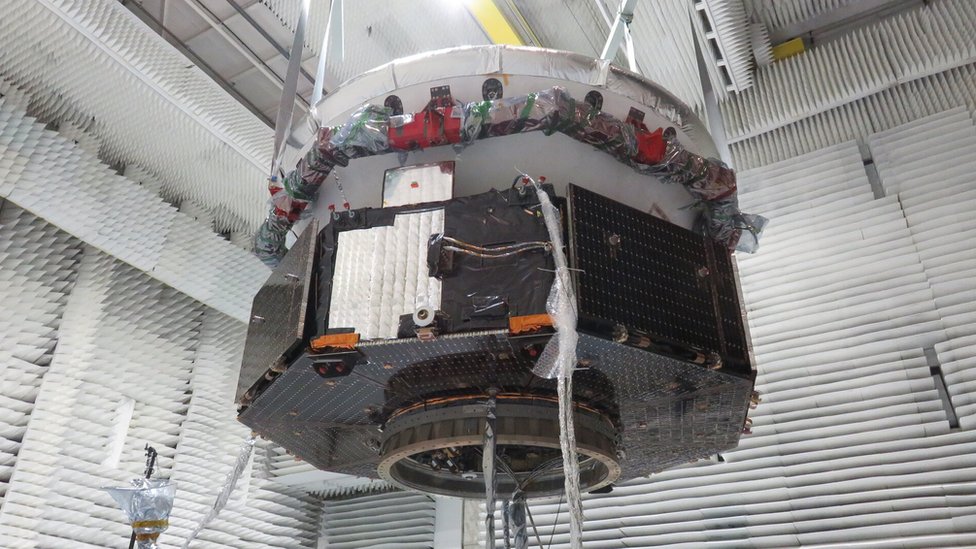 IMAGE COPYRIGHTTHALES ALENIA SPACE
IMAGE COPYRIGHTTHALES ALENIA SPACE
